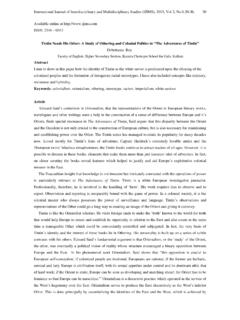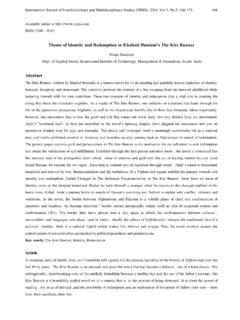Transcription of The Concept of Social Vulnerability: A Review from ...
1 International Journal of Interdisciplinary and Multidisciplinary Studies (IJIMS), 2014, Vol 1, , 71-82. 71 Available online at ISSN: 2348 0343 The Concept of Social vulnerability : A Review from Disasters Perspectives Sapam Ranabir Singh * , Mohammad Reza Eghdami and Sarbjeet Singh Department of Anthropology, Panjab University, Chandigarh *Corresponding Author: Sapam Ranabir Singh Abstract vulnerability is made up of the characteristics of a person or group and their situation that influence their capacity to anticipate, to cope with, resist and recover from the impact of a natural hazar d. This research paper is based on the various reviews with special focus on the text of Social vulnerability due to natural disasters.
2 Social vulnerability is determined by various factors such as physical, Social , economic, and environmental factors or processes, which increase the susceptibility of a community to the impact of hazards. Poverty, occupation, caste, ethnicity, exclusion , marginalization and inequities in material consumption of a society or community also enhance Social vulnerability . Some people within the Social systems like ethnic minorities, disempowered castes or classes, religious groups, or occupations may live or work in physical areas that are relatively disaster-prone. So to solve the issue of Social vulnerability in the long run process there must be interdisciplinary and cross-cultural studies of natural disaster impacts and Social vulnerabilities.
3 Social scientists needs to continue to seek practical ways to incorporate local technical knowledge, insight, skills, desires, and needs into the management of disaster situations, so that local people and institutions might be affirmed in identifying problems and offering solutions towards the management of their own situation, and that local capacities may be strengthened to resist future emergencies. Key Words: Social vulnerability , Poverty, Marginalization, Caste, Ethnicity, Natural Hazard, Disasters Introduction Understanding vulnerability requires more than simply understanding societies past and present relations with regard to disaster and development. vulnerability is also about people, their perceptions and knowledge.
4 People s ideas about risk and their practices in relation to s disaster constitute the sextant and compass with which they measure and chart the landscape of vulnerability (Hilhorst and Bankoff, 2006: 4). The International Strategy for Disaster Reduction (UN/ISDR: 2004) defines vulnerability as the conditions determined by physical, Social , economic and environmental factors or processes, which increase the susceptibility of a community to the impact of hazards. Whereas in contrast of ISDR, the United National Development Programme (UNDP) defines vulnerability as a human condition or process resulting from physical, Social , economic and environmental factors, which determine the likelihood and scale of damage from the impact of a given hazard (UNDP 2004:11).
5 vulnerability may be defined as an internal risk factor of the subject or system that is exposed to a hazard and corresponds to its intrinsic predisposition to be affected, or to be susceptible to damage. In other words, vulnerability represents the physical, economic, political or Social susceptibility or predisposition of a community to damage in the case of a destabilizing phenomenon of natural or anthropogenic origin (Cardona 2006: 37). It is fundamentally a political ecological Concept which focuses on the relationship that people have with their environment as well as s close attention to the political economic forces characteristic of the society in which they live that shape and condition that relationship.
6 At least from the perspective of hazards and disasters, vulnerability is the conceptual nexus that links the relationship that people have with International Journal of Interdisciplinary and Multidisciplinary Studies (IJIMS), 2014, Vol 1, , 71-82. 72 their environment to Social forces and institutions and the cultural values that sustain or contest them. Thus, combining elements of environment, society and culture in various proportions, the Concept of vulnerability provides a theoretical; framework that encompasses the multidimensionality of disasters (Blaikie et al. 1994; Comfort et al. 1999; Cutter 1996; Hewitt 1983b). At the same time Cannon is also of the opinion that vulnerability is a characteristic of individuals and groups of people who inhabit a given natural, Social and economic space, within which they are differentiated according to their varying position in society into more or less vulnerable individuals and groups.
7 It is complex characteristic produced by a combination of factors derived especially (but not entirely) from class, gender and eth nicity (1994:19). Whereas in the Hazards-of-Place Model of vulnerability as shown in fig. 1 of Cutter et al. (2003) vulnerability is identified as a combination of risk of hazardous events both from the context of biophysical as well as Social vulnerability . Research methods This research paper is based on the Review of various studies of Social vulnerability due to natural disasters. Some are empirical studies whereas some papers are theoretical and conceptual studies. Based on the secondary data piled up from the various journal articles, books, documents and seminar/ conference proceedings, the Concept of Social vulnerability is tried to discus in this research paper.
8 Conceptualizing Social vulnerability : A Review Analysis The text of Social vulnerability is a by-product of Social inequalities. It is defined as the susceptibility of Social groups to the impacts of hazards, as well as their resiliency, or ability to adequately recover from them (Cutter and Emrich 2006) and a Social dynamic rooted in gender, class, race, culture, nationality, age, and other power relationships (Enarson, Fothergill, and Lori 2006). Social vulnerability is influenced by a variety of factors. Social class is one of the largest contributors to Social vulnerability (Burton and Cuter 2008). It includes employment (type and stability), income, savings, and education levels (Zahran et al.)
9 2008; Burton and Cutter 2008; Cutter 2006a; Fothergill and Peek 2004; Dwyer et al. 2004; Lindell and Perry 2004; Cutter et al 2003; Buckle et al 2000; Mileti 1999; Morrow 1999; Bolin and Stanford 1998; Dash, Peacock and Morrow 1997; Blaikie et al. 1994), the quality of human settlements (housing type and construction, infrastructure and lifelines) (Dwyer et al., 2004; Cutter et al. 2003; Bolin Stanford 1998), tenure type (Dwyer et al. 2004; Cutter et al. 2003), built environment, family structure (Cutter et al. 2003; Buckle et al. 2000; Morrow 1999) population growth, commercial and industrial development, medical services, and special needs population (Cutter et al. 2003). This is a central component of vulnerability , particularly in combination with other marginalization factors (Blaikie et al.
10 1994) and these factors have an influence on economic losses, injuries and fatalities from natural hazards (Cutter et al. 2003). Race and ethnicity also contribute to Social vulnerability through a lack of access to resources (based on language, culture, educational levels), the economic marginalization that is often associated with racial and ethnic disparities (Burton and Cutter 2008; Wisner et al. 2004; Cutter et al 2003; Bolin and Stanford 1998) and age (specifically elderly) (Burton and Cutter 2008; Cutter 2006a; Dwyer et al. 2004; Cutter et al. 2003; Buckle et al. 2000; Morrow 1999; Bolin and Stanford 1998; Blaikie et al. 1994) as well as gender (females considered more vulnerable than males) (Burton and Cutter 2008; Dwyer et al.









